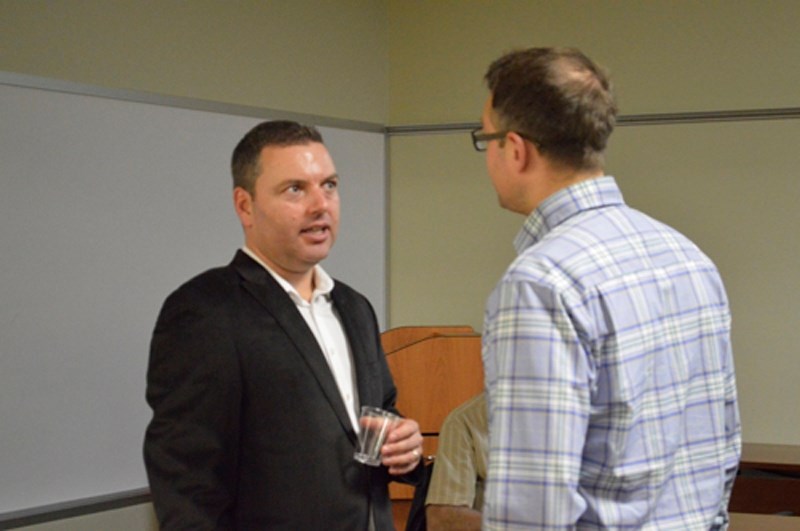The visitor friendly community and regional assessment project (VFCRA) conducted by Mountain View County (MVC) and the towns of Olds and Sundre has made recommendations for improvements in all three communities.
Working groups will now be established to move forward with possible implementation of those improvements, Greg Campkin, the chairman of the steering committee overseeing the project, told the Gazette.
The assessment's final report was released to stakeholders on Oct. 16 following site visits in all participating communities.
The assessment was conducted to identify how the region presents itself to visitors and to identify ways of helping all three communities attract more visitors, strengthen tourism infrastructure and increase visitor satisfaction.
The assessment study area was the northwest-central area of the county: Highway 2 on the east, Eagle Hill Road (Twp. Rd. 340) on the north, Bergen Road on the south and the county boundary on the west.
A multi-stakeholder committee oversaw the project in conduction with Expedition Management Consulting. There were three principal objectives of the project:
• Complete visitor friendly assessment and develop action plans supported by the municipalities.
• Incorporate an approach that addresses Mountain View County including the Town of Olds and the Town of Sundre as a regional tourism destination.
• Develop a final report that compiles all information and work gathered from the project.
The project was the first of its kind in Alberta where the assessment was conducted on a regional basis.
The assessment team spent May 20 and 21 touring all three participating communities, followed by followup visits on July 3 and July 23.
Team members focused their assessments on five criteria: overall ambience/community visual appeal; wayfinding/signage; public services/visitor amenities; quality of service/professionalism; and visitor information.
Key strengths identified in the region as a whole were as follows:
• Outstanding natural assets including proximity to four distinct biomes (prairies, boreal forest, foothills and mountains).
• Strategic location close to the Highway 2 corridor, the Cowboy Trail, an international airport, major urban centres and to the mountains.
• Regional service hubs in Olds and Sundre.
• Strong volunteer base.
• Supply of camping opportunities and other outdoor experiences.
• High-quality roads and other infrastructure to support visitation.
The nine main “opportunities for improvement” identified were as follows:
• Lack of data available to understand who visitors are, where they are from and what they like and don't like.
• New product development occurs on an ad-hoc and uncoordinated basis from various organizations.
• Lack of a coordinated approach to promoting tourism product and providing visitor information.
• Lack of tourism product and lack of product packaging.
• Lack of coordination between visitor information centres.
• Limited coordinated access to provincial tourism resources.
• Lack of coordination in pooling/leveraging resources to address gaps.
• Lack of coordinated service sector staff training and standards.
• Lack of a joint commitment to fund tourism initiatives.
As well as the assessment of each community, the report's authors also included a detailed action plan to address local and regional improvements.
The report's authors recommended that the partner municipalities create a regional visitor friendly working group, as well as three local working groups.
The regional group would be comprised of key stakeholders and would work towards the implementation of improvements outlined in the action plan.
Goals outlined for MVC include “enhance the visual appearance of roads, highways and open space”, “improve the consistency and effectiveness of highway tourism signage”, “enhance customer service and marketing programs”, “enhance visitor amenities for the travelling public by making attractive roadside amenities” and “enhance opportunities for short term camping.”
Goals outlined for Olds include “enhance streets and public spaces throughout the community are clean, well-maintained and attractive”, “ensure private properties are clean, well-maintained and attractive”, “enhance streetscape character in the Uptowne Olds District”, “expand public art through the community”, “improve wayfinding for visitors” and “ensure public spaces and pedestrian areas are safe and accessible.”
Goals outlined for Sundre include “ensure streets and public spaces are clean, well-maintained and attractive”, “improve the visual appearance of west entry to Sundre”, “expand public art in the community”, “improve wayfinding signage for visitors” and “reduce highway sign clutter.”
Regional goals include “encouraging standardized, professional and consistent customer service in the tourism sector”, “promoting tourism as a valuable economic driver in the community in order to increase awareness from citizens and decision makers” and “enhance coordination among visitor information centres.”
The report's authors concluded that the three partner municipalities should “start thinking about how the three destinations can leverage resources and collaborate to focus on high value activities that enhance the region.”
Steering committee chairman Greg Campkin says with the release of the final report, the work will now focus on putting together working groups. “The idea is to now establish working groups in all three municipalities,” said Campkin. “The steering committee will guide the regional part and the working groups would guide the individual municipality objectives or action plans.
“The future goal is to try and present to Didsbury, Carstairs and Cremona and try to expand the region. The overarching goal was to get cooperation among the three original municipalities and then start to try to develop the whole area as a tourism destination.”
The steering committee will meet again this month to “discuss what the future process could work and look like. We'd like to get started with the working groups by the beginning of next year.”
The VFCRA project assessment cost $40,000, with each municipality paying $3,000 and the province matching on a three-to-one basis, he said.
"The overarching goal was to get cooperation among the three original municipalities and then start to try to develop the whole area as a tourism destination."Greg CampkinCommittee chairman



